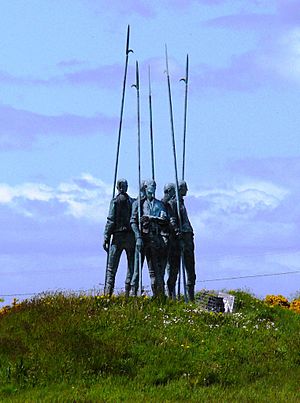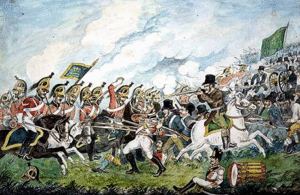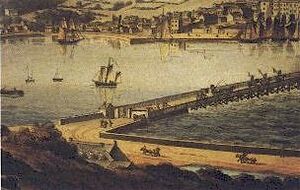Wexford Rebellion facts for kids
The Wexford Rebellion was a major uprising in County Wexford, Ireland, in May 1798. It was part of a larger rebellion by the Society of United Irishmen against British rule. This rebellion was the most successful and destructive of all the uprisings during the 1798 Rising. It lasted from May 27 to about June 21, 1798. The Wexford Rebellion succeeded even though the government did not see County Wexford as a big threat. This was because of quick uprisings that happened before and after important rebel wins in Oulart, Enniscorthy, and Wexford town.
Contents
The Start of the Wexford Rebellion
The group called the Society of United Irishmen in County Wexford stayed strong. This was despite efforts to weaken the organization in other counties. In May 1798, the British arrested Anthony Perry from Inch. He was a former military officer and a leader in the United Irishmen.
News of arrests and a sad event in Wicklow spread quickly. This event was known as the Massacre of Dunlavin Green. On the night of May 26, rebels, also called "Croppies," gathered in north County Wexford. They attacked military and loyalist targets to get weapons. The government quickly sent in troops, known as "Yeomen."
Early Rebel Victories
The next morning, rebels gathered at Oulart Hill and Ballyminaun Hill. At Ballyminaun, the rebels were defeated. However, they won a big victory at Oulart Hill. This win was led by Father John Murphy and others. They defeated a company of soldiers there.
On their way to Enniscorthy, the Croppies grew in number to about 6,000. They won in Enniscorthy on May 28. Two days later, they took Wexford town from Colonel Maxwell. After the Battle of Three Rocks, the rebels took Wexford town and county on May 30. This ended the first part of the Wexford Rising. The number of rebels grew to 10,000.
The Middle Phase of the Rising
The second part of the rebellion happened between June 1 and June 21, 1798. The people of County Wexford set up a new government. This government was led by civilians. They decided to divide the Wexford rebels into two groups. One group would go north toward Dublin, and the other west toward New Ross.
The Battle for New Ross
The group sent toward New Ross faced many challenges. They attacked on June 5 and took most of the town. There was intense fighting in the streets with many losses. The Croppies had to retreat after a counterattack when they ran out of ammunition. This group was greatly weakened after the Battle of New Ross.
John Kelly of Killanne was a rebel leader. He was told not to attack New Ross town itself. The rebels had more fighters than the British forces. A messenger was sent to ask the British to surrender. When this messenger was harmed, the rebels attacked. Kelly's group of 800 men broke into New Ross. Kelly was injured as they retreated.
The Scullabogue Incident
After the Battle of New Ross, a sad event happened at Scullabogue. Rebel soldiers had gathered about 200 civilians in a building. They thought these people supported the British. News came from New Ross that British soldiers had harmed rebel aid stations. When they heard this, some rebels closed the doors and set the building on fire. Many people inside were lost.
The other rebel group was defeated at Arklow. This would have been a big win for them. But they lost on June 9 because they ran out of ammunition.
The Final Days of the Rebellion
The Wexford Croppies finally faced defeat. General Lake launched several attacks. Rain fell on the county for the first time since the rebellion began. General Lake's men entered the county from five different places. By June 20, the remaining rebels were pushed back to Vinegar Hill.
The Fall of Wexford Town
General Lake took Enniscorthy and Vinegar Hill on June 21. This was despite a brave defense by William Barker and Father Moses Kearns. The British forces then pushed all the way into Wexford town. The rebel government was ended, and rebels fled. Many important rebel leaders were captured and executed.
Why Did the Rebellion Happen?
After the British ended the rebellion, many people in Ireland believed it was caused by religious differences. They thought it was between Catholics and Protestants. However, during the rebellion, important rebel leaders said it was for political reasons. They said it was not about religion.
Some sad events during the rebellion might suggest religious tensions. But the United Irishmen group included both Protestants and Catholics. Also, the new government formed in County Wexford showed it was a political movement. Grain prices dropped in 1797 and 1798. This was partly because of new taxes on the malt industry. This caused hardship in many areas, especially Wexford. Mostly, the rebels fought for changes in laws and for a fairer sharing of political power.
See also
- Bagenal Harvey, John Henry Colclough, Cornelius Grogan, Matthew Keogh, Philip Roche, John Kelly of Killanne - Some rebel leaders.
- Anthony Perry, Mogue Kearns, John Murphy, Michael Murphy - Other rebel leaders.




